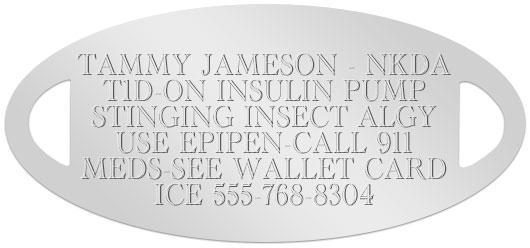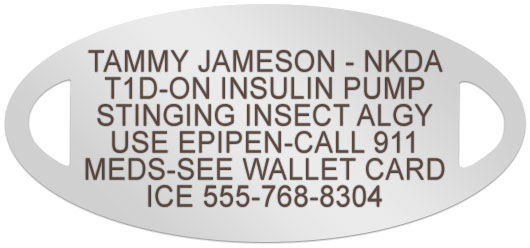What Do I Really Need To Engrave On My Medical Alert?
When engraving medical ID alert bracelets , it’s very important to remember that the person reading your medical alert bracelet or necklace will likely never have met you and will know nothing about you. If you’ve been in an accident or other emergency, you may not have your wallet or purse close at hand, so all of the essentials need to be accessible on your medical ID tag.
When it comes to engraving your medical alert bracelet, there are a lot of options, but we recommend:
Your full name:
If there’s room after your name, consider using the rest of the line. For example, “JOE SMITH – 4/11/85” or, “JANE SMITH – NKDA” (NKDA stands for No Known Drug Allergies, and it is a very common medical abbreviation that communicates extremely helpful information).Your chief medical condition(s) or concern(s):
Many common medical conditions have abbreviations that EMTs and other first responders know well. If you’re not sure about yours, reach out to us, or check out our common abbreviations list. Also, if you find that your engraving is just a character or two over the limit, give us a call. Sometimes, we can make it fit, depending on the letters/characters involved. For example, “Adrenal Insufficiency” takes up 21 characters, one more than our standard 20, but it will fit on our typical medical ID tags.Your allergies or medications:
Often, people will simply engrave the name of a medication, such as, “Hydrocodone,” or “Immitrex.” This does not tell rescue personnel whether you are taking these medications regularly or if you are allergic to them. So it’s important to make that distinction: “On Hydrocodone,” or “Algy Immitrex.” Otherwise, an EMT may assume you are allergic to a medication, when actually you are taking it, which could result in drug interactions or medications being withheld that should actually be administered.Your emergency contact information:
Typically, engraving the word, “ICE” before a phone number is sufficient here. There is no reason to designate that the ICE (In Case of Emergency) contact is your mom or that her name is Janice, as she can explain that if she gets a call. Instead, save those extra characters for your medical information. If you have enough space, having an extra ICE contact is always a great idea. The only time we recommend including a name is when you list someone’s work phone number, so the EMTs will know who to ask for.
What is Standard Etched Engraving?

What we call standard, traditional, or rotary engraving is what most people think of when they consider engraving. With most of our ID tags, this results in a tone-on-tone appearance, achieved when our engraving machine essentially carves the letters into the metal (it’s the same technique used on many trophies or plaques that you might have seen.)
What is Premium Laser Engraving?

With laser engraving, there is no contact between an engraving tip and the tag. In this instance, a laser actually burns the text onto the tag itself. Laser engraving is a permanent process, and while it may look like it’s printed on, it’s actually burned into the metal and results in dark lettering that really stands out on your medical ID and can greatly increase the ease of reading, especially in low-light situations.
Running low on engraving space? These abbreviations may be helpful when engraving your medical alert:
| Atrial Fibrillation | A-Fib |
| Allergy/Allergic To | ALGY |
| Aortic Valve Replacement | AVR |
| Aspirin | ASA |
| Blood Pressure | BP |
| Cancer | CA |
| Chronic Kidney Disease | CKD |
| Chronic Obstructive Pulmonary Disease | COPD |
| Congenital Adrenal Hyperplasia | CAH |
| Congestive Heart Failure | CHF |
| Coronary Artery Disease | CAD |
| Coronary Heart Disease | CHD |
| Cystic Fibrosis | CF |
| Deep Vein Thrombosis | DVT |
| Defibrillate/Defibrillation | DEFIB |
| Diabetic Ketoacidosis | DKA |
| Diabetes Mellitus | DM |
| Diagnosis or Disease | DX/DIAG |
| Discontinue | D/C |
| Do Not Resuscitate | DNR |
| Epinephrine | EPI |
| Epinephrine Pen (auto-injector) | EPIPEN |
| Erythromycin Ethylsuccinate | EES |
| History | HX |
| Hypertension | HTN |
| In Case of Emergency | ICE |
| Insulin-Dependent Diabetes Mellitus | IDDM |
| Intravenous | IV |
| Idiopathic Thrombocytopenic Purpura | ITP |
| Medication(s)/Prescription(s) | MED/MEDS/RX/RXS |
| Mitral Valve Prolapsed | MVP |
| Nasogastric | NG |
| No Known Allergies | NKA |
| No Known Drug Allergies (used for people who have known non-drug allergies but no known allergies to medications) | NKDA |
| Penicillin | PCN |
| Tetracycline | TCN |
| Tracheal/Tracheotomy | TRACH |
| Transplant or Treatment | TX (requires context) |
| Von Willebrand’s Disease | VWD |
Our standard medical alert tags have six lines for you to work with, and with a few abbreviations, most customers are easily able to fit their most pertinent medical information on their tags.
Do you have engraving questions?
Give us a call between 8 a.m. and 4:30 p.m. central time, Monday through Friday, at 1.800.360.8680.
Tara Cohen, Director of Sales, Marketing, and Business Development
LH Team Member Since 2012
University of California Santa Barbara
LinkedIn Profile: https://www.linkedin.com/in/taracohen
As Director of Sales, Marketing, and Business Development for Lauren’s Hope, Tara Cohen is often the voice of Lauren’s Hope. Whether she’s writing the Lauren’s Hope blog, crafting a marketing email, or describing a new product, Cohen brings a little personal touch to everything she creates.
“One of my favorite things about Lauren’s Hope is that we are truly here to help people. My first interaction with Lauren’s Hope was as a customer, and the helpful, caring manner in which the LH team supported my son’s needs was truly remarkable. It’s an experience I want our customers to have every time they visit the site. That’s why I always strive for a conversational, friendly tone of voice. I write the way we would speak to our customers if they walked into a Lauren’s Hope storefront.”
Part of the LH team since 2012, Cohen has spent years learning about various medical conditions and what engravings are most helpful for each.
“We always remind our readers that we are not medical professionals. We aren’t doctors or nurses. We are, however, medical ID experts. We talk to customers, first responders, and medical professionals every day about any condition you can imagine, and we discuss what information a first responder needs to know when someone has that condition. I am so grateful to have the opportunity to share some of that knowledge over on the LH blog.”
In addition to her years of experience at Lauren’s Hope and all of the research she puts into writing for LH, Cohen draws on her own life experiences to bring a human touch to the LH blog.
“Around here, we like to say, ‘Everyone knows someone who needs a medical ID,’ and that holds true for me as well. In fact, most of my family and many of my friends and their children wear Lauren’s Hope medical IDs.
“Personally, I have a salicylate intolerance and some pretty scary food and drug allergies, which I’ve written about at length.
“My son is nonverbal and has autism, OCD, non-celiac gluten sensitivity, and sensory integration dysfunction. I’ve written a lot about Will, including our journey with his feeding aversion, which resulted in a two-week hospitalization and subsequent feeding tube placement. I still get emails and calls from moms whose kids are going through feeding aversion therapy or who have been recently diagnosed with autism, and I am so grateful to have the chance to connect with them.
“I have other family members and friends who wear our medical IDs for food and drug allergies, heart conditions, medication restrictions, diabetes, autoimmune diseases, blood thinner use, and more. Being able to help them choose the right med ID with the right engraving is very rewarding. I always tell them the same thing I tell all of our customers, ‘I hope you’ll never need it, but I am so glad you have it.’”
Areas of Expertise
eCommerce
Content Creation
Digital Marketing
Email Marketing
Product Development
Business Development
Brand Management
Professional Honors and Memberships
Member, Forbes Business Development Council, 2018 & 2019
Nominee, Kansas City’s Women Who Mean Business Awards, 2019
Commerce Review Panelist | ROI Revolution’s PPC and Marketing Summit, 2017
Guest Speaker, Kids With Courage (Type 1 Diabetes, KC charity) Annual Gala, 2016
Service Recognition Award, Kids With Courage Annual Gala, 2015
Nominee and Finalist, Kansas City’s NextGen Leader Awards, 2015 & 2016
Google AdWords and Analytics Certified, 2015
University of Florida’s Center for Autism and Related Disabilities (CARD) Guest Speaker | Touch-Screen Communication Technology for Children with Autism
Publications
Guest Author, Parenting Children With Special Needs Magazine, “The Most Important Purchase I Ever Made.” | 2017
Contributing Author, Forbes.comHow to Get The Most Out of Every Conference
Yes, You Really Need Reviews
Five Uncomfortable Questions You Must Ask New Vendors
Guest Author, Parenting Children With Special Needs Magazine, “The Most Important Purchase I Ever Made.” | 2017
